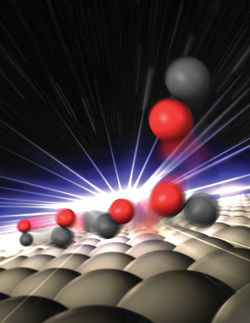Team of Canadian and Russian collaborators identified a new class of "biozeolites"
Peptides as a new class of microporous organic solids
Advertisement
The catalysts, micro reaction chambers, molecular storage, and molecular sieves often consist of solids with microscopic cavities. The most important and versatile class of porous materials is the family of silicates known as zeolites. However, porous frameworks aren't found exclusively in inorganic materials. Organic materials can also be crisscrossed by narrow channels. A team of Canadian and Russian collaborators has now identified a new class of "biozeolites" made of simple peptides.
For their experiments, Dmitry V. Soldatov, Igor L. Moudrakovski, and John A. Ripmeester chose to use a very simple type of protein. They limited themselves to two protein building blocks, the amino acids valine and alanine, and hooked them together. The result is two different dipeptides, depending on which amino and acid groups are coupled: alanyl-valine (AV) and valyl-alanine (VA). Both crystallize as microporous solids.
The crystals consist of spiral dipeptide chains, each with an open channel in the center. These little channels are not straight, but twisted. What is unusual is that all of the channels are twisted in the same direction, to the right. The image and mirror image, in this case right- and left-turning spirals, are not identica.
Amino acids are also chiral, the naturally occurring form being the "left" version-which leads to right-handed channels in the dipeptide crystals. Materials with chiral channels are difficult to produce, but are highly desirable because they are used for the often decidedly difficult separation of the "left" and "right" versions of chiral molecules.
Although the AV and VA crystals have very similar structures and dimensions, there are distinct differences: the noble gas xenon is held much more tightly by VA channels than by the AV pores. The reason for this seems to be the slightly smaller pore diameter of the VA crystals; the smaller cavities result in more intensive interactions between the gas atoms and the pore walls.
If the diversity of possible small peptides is taken into consideration, many different porous materials couldt be produced: The type, number, and order of the coupled amino acid building blocks could perhaps be used to tailor the pore properties of these "biozeolites" for particular applications. Nontoxic peptides would also be suitable for biomedical applications.
Organizations
Other news from the department science

Get the chemical industry in your inbox
By submitting this form you agree that LUMITOS AG will send you the newsletter(s) selected above by email. Your data will not be passed on to third parties. Your data will be stored and processed in accordance with our data protection regulations. LUMITOS may contact you by email for the purpose of advertising or market and opinion surveys. You can revoke your consent at any time without giving reasons to LUMITOS AG, Ernst-Augustin-Str. 2, 12489 Berlin, Germany or by e-mail at revoke@lumitos.com with effect for the future. In addition, each email contains a link to unsubscribe from the corresponding newsletter.



























































